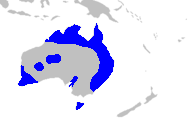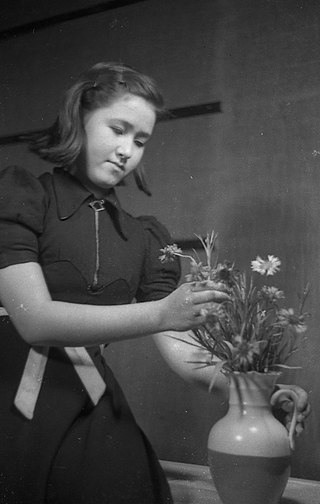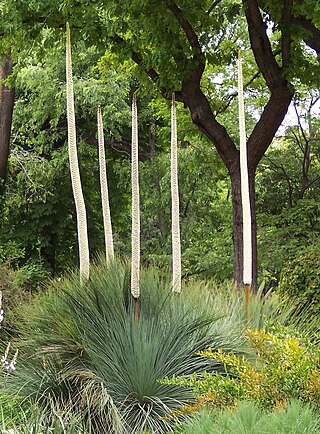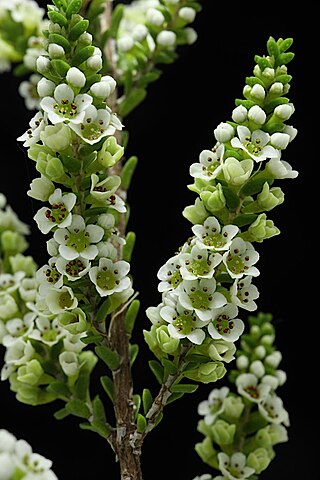
Crowdy Bay is a national park in New South Wales, Australia, 271 km northeast of Sydney.

Xanthorrhoea is a genus of about 30 species of succulent flowering plants in the family Asphodelaceae. They are endemic to Australia. Common names for the plants include grasstree, grass gum-tree, kangaroo tail, balga, yakka, yamina (Tasmania), and black boy. The most common species is Xanthorrhoea australis, and some of these names are applied specifically to this species.

Floral design or flower arrangement is the art of using plant material and flowers to create an eye-catching and balanced composition or display. Evidence of refined floral design is found as far back as the culture of ancient Egypt. Floral designs, called arrangements, incorporate the five elements and seven principles of floral design.

Xanthorrhoea australis, the grass tree or austral grasstree, is an Australian plant. It is the most commonly seen species of the genus Xanthorrhoea. Its trunk can grow up to several metres tall and is often branched. In certain Aboriginal languages, it is called bukkup, baggup or kawee.
Stylidium austrocapense is a dicotyledonous plant that belongs to the genus Stylidium. The specific epithet austrocapense refers to this species' native range on the southern part of Cape York Peninsula in Australia. It is an herbaceous annual plant that grows from 9 to 18 cm tall. Oblanceolate or elliptical leaves, about 4-40 per plant, form a basal rosette with stems absent. The leaves are generally 7.5–31 mm long and 2–10 mm wide. This species produces 1-10 scapes per plant that are glandular-hairy. Inflorescences are 9–18 cm long and produce pink or red flowers that bloom from April to July in their native range. S. austrocapense is endemic to the Cape York Peninsula in Queensland, Australia. Its typical habitat has been reported as coarse white sandy soils on low hills or intermittent watercourses. Dominant vegetation in association with its habitat include Eucalyptus tetrodonta, E. clarksoniana, Melaleuca viridiflora, M. nervosa, and Xanthorrhoea johnsonii. S. austrocapense is most closely related to S. multiscapum, but differs by the shorter leaves and absent paracorolla. Its conservation status has been assessed as secure.

Johnson's seagrass is a small, asexual seagrass in the family Hydrocharitaceae. It has been called Halophila johnsonii, but is now considered to be a clone of the widespread species Halophila ovalis. As of March 2024, Plants of the World Online treats Halophila johnsonii as a synonym of Halophila ovalis subsp. ovalis. Johnson's seagrass occurs only on the southeastern coast of Florida, in lagoons along roughly 200 km of the Florida coastline between Sebastian Inlet and the northern part of Biscayne Bay, where it grows in small patches of a few centimeters to a few meters in diameter at depths ranging from the intertidal zone down to 3 meters. It was the first marine plant listed on the United States endangered species list, though it was removed from the listing in April 2022.

Halophila ovalis, commonly known as paddle weed, spoon grass or dugong grass, is a seagrass in the family Hydrocharitaceae. It is a small herbaceous plant that naturally occurs in sea beds and other saltwater environments in the Indo-Pacific. It was introduced as isolated populations in Florida, Cuba and Antigua.

The flora of Australia comprises a vast assemblage of plant species estimated to over 21,000 vascular and 14,000 non-vascular plants, 250,000 species of fungi and over 3,000 lichens. The flora has strong affinities with the flora of Gondwana, and below the family level has a highly endemic angiosperm flora whose diversity was shaped by the effects of continental drift and climate change since the Cretaceous. Prominent features of the Australian flora are adaptations to aridity and fire which include scleromorphy and serotiny. These adaptations are common in species from the large and well-known families Proteaceae (Banksia), Myrtaceae, and Fabaceae.

The Donnelly River is a river in the South West of Western Australia. Its main tributaries are Barlee Brook and Carey Brook. The river runs primarily through state forest reserves, although 25 private landholdings are situated along the length of the river. Clearing of the catchment area is estimated at 20% with the land mostly being used for viticulture, horticulture, dairy, grazing and tourism.

Xanthorrhoea preissii, known as balga, is a widespread species of perennial monocot in Southwest Australia.

Xanthorrhoea quadrangulata or the Mount Lofty Grass Tree is a plant in the genus Xanthorrhoea. It is the only species of Xanthorrhoea solely endemic to the state of South Australia.

Grevillea johnsonii, commonly known as Johnson's grevillea or Johnson's spider flower, is a species of flowering plant in the family Proteaceae and is endemic to New South Wales. It is a shrub with divided, needle-like leaves and red to orange flowers, and grows in rocky places.

Sclerocactus johnsonii is a species of cactus known by the common names Johnson's beehive cactus and Johnson's fishhook cactus. It is native to the southwestern United States from eastern California to Utah and northwestern Mexico, where it can be found in desert scrub habitat. It produces an egg-shaped or cylindrical stem up to 25 centimetres tall by 10 centimetres wide. It is covered densely in straight and curving spines which may be up to 4 centimetres long and come in shades of yellow, gray, lavender, and pink or red, with up to 24 per areole. The cactus may have yellow or pink flowers; the species is sometimes divided into two varieties on the basis of flower color. Flowers are up to 8 centimetres wide. The scaly, fleshy fruit is up to 1.8 centimetres long.

Xanthorrhoea macronema is a forest plant in the genus Xanthorrhoea, found in coastal regions of eastern Australia north of Sydney, New South Wales to Fraser Island, Queensland. The trunk of this grass tree is underground.

Xanthorrhoea glauca, known as the black boy or grass tree, is a large plant in the genus Xanthorrhoea, widespread in eastern Australia. The trunk can grow in excess of 5 metres tall, and may have many branches. It is occasionally seen in large communities in nutrient rich soils. The leaves are a grey or bluish glaucous green.

Xanthorrhoea malacophylla is a species of grasstree of the genus Xanthorrhoea. It is endemic to New South Wales, Australia. Mature plants form a single or branched trunk that ranges between 2 and 6 metres in height. The grass-like leaves, which are usually around 3 mm wide, are distinguished from other species by their softness and sponginess. The flowers appear between May and September in scapes that are between 1.3 and 1.8 metres long.

Xanthorrhoea semiplana is a species of grass tree found in south-eastern Australia, with two subspecies:

Micromyrtus grandis, commonly known as Severn River heath-myrtle, is a species of flowering plant in the myrtle family. It is an upright, monoecious shrub with egg-shaped, oval or elliptic leaves arranged in opposite pairs and white to cream-coloured flowers arranged singly in leaf axils.

Xanthorrhoea gracilis, commonly known as the graceful grasstree, grassboy or mimidi, is a species of grasstree of the genus Xanthorrhoea native to Western Australia.

Xanthorrhoea thorntonii, commonly known as Cundeelee grasstree, Cundeelee blackboy, desert grasstree, yacka or grasstree, is a species of grasstree of the genus Xanthorrhoea native to central Australia. It is known to the Pitjantjatjara people as kata-kultu, kata-puru, ulpa or urara, the Warlpiri people as yurlurnkuru and the Arrernte as lunkere. X. thorntonii is the only grass tree found in Central Australia including the Great Sandy Desert, Great Victoria Desert and MacDonnell Ranges.



















